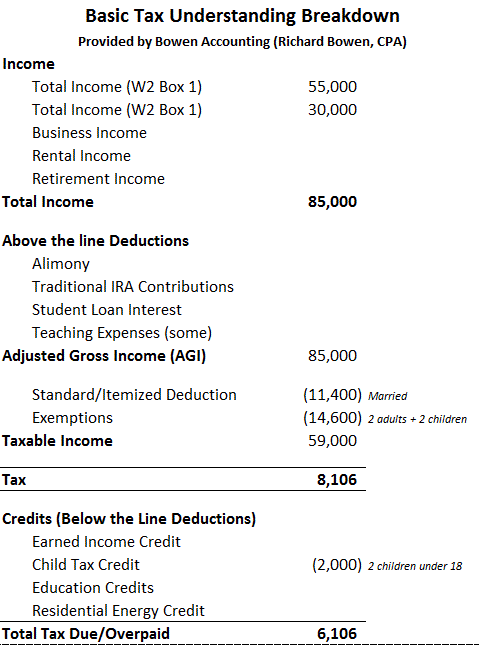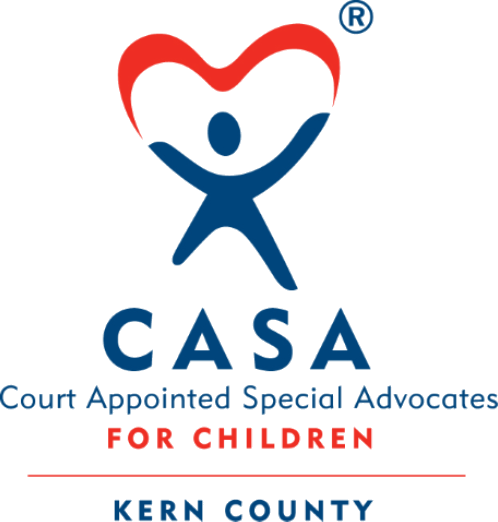If you have any comments about our articles you can email Richard Bowen, CPA
Understanding your tax return
Who needs to file a tax return?
Generally, if you have income, you need to do a tax return. This is a basic rule, even if you are under the age of 18, or if you are someone's dependant, you probably still need to file a return. There are numerous rules that tax preparers have to stay up to date on regarding the specifics about who needs to and who has to file a tax return. However, the basic rule does not change.
If you make very little money (under $12,000 as of 2020), but had federal or state withholdings taken out, you may not be required to file, but probably should because you are likely entitled to get you withholdings refunded to you.
Understanding withholding
To understand what a refund is, first you have to understand the withholdings process. Like most Americans, you are probably an employee, as opposed to being self-employed (business owner/contractor). Employees fill out a form W4 when they begin working for a new employer. This form tells the employer how much money to withhold (remember this word, we are going to be talking about it a lot). The form tells them what your filing status and exemptions are. Sound complicated? Well, it is not.
(The Trump tax law changes in 2018, significantly changed the way dependent expemptions were treated. most of the information about allowances still apply for most states, but not for the IRS. The new 2020 W4 focuses on filing status and number of dependend credits. The explanation below is still helpful)
Your filing status is generally based on your marital status (married or single). This is filled in at line 3. Your exemptions, or allowances, are the number of people you are allowed to 'claim', or write off on your tax return, and are put on line 5. See the examples below.
- If you are single and live with your parents then your allowances are 0.
- If you are single and live on your own your allowances are 1.
- If you are married with no children your allowances are 2.
- If you are married with children, your allowances are 2 + the number of children you have.
You are not required (will not get in trouble) to claim what you actually are. You can be married with children and claim, single with 0 allowances. This form is for you to tell your employer how much money you want withheld from your paycheck and sent to the taxing authorities on your behalf. Many people who want more money on their paycheck will claim higher than what they are so that fewer taxes are withheld. A single person might claim married with 7. This is generally a bad idea. You can always claim less that you actually are, because this will cause more money to be sent to the taxing authorities on your behalf, but you should rarely claim more than you are because it would have the opposite effect.
After turning in the W4 to your employer on each of your paycheck stubs you will be able to see how much money they are withholding (there is that word again). The money they are withholding is sent to the IRS and state taxing authorities (if applicable) as an estimate against your annual tax liability.
At the end of each year you get a W2 from your employer reporting the total wages and taxes you paid. The total in box 2 of the W2 is your federal withholdings. This is the amount of money that has been taken from your check and paid to the taxing authorities as an estimate. Now we need to understand how this figures into your 'tax return' (actually known as your tax refund).
What is a tax refund (commonly known as a tax return)?
Later we will get into exactly how your total tax for the year is calculated, but for now you just have to understand that it is based on your filing status (generally your marital status), and the number of exemptions you have.
Your total income, which is box 1 on your W2, is added (if you have multiple forms), deductions are taken out of that, your tax is calculated, credits reduce your total tax, and your final annual tax is the net total. Your total withholdings are subtracted from total tax and the difference is either what you owe or what the taxing authorities owe you.
If you have had more money withheld, than you owe in tax, you will get the difference refunded to you. If you have had less withheld than you owe you will have to pay the taxing authorities additional money.
Note: Commonly people refer to any money the will get back after filing their tax return as their 'tax return'. This is incorrect, your tax return is the compilation of forms that need to be filled out and sent to the taxing authorities with a copy of certain records. Any money you get back after completing this packet is called a 'tax refund'. Now it is time to understand how your tax is actually calculated.
How is tax calculated?
Taxes, tax returns, tax code, and tax law are very complicated. This is the reason that an entire industry exists to perform the services related to understanding and filing tax returns. The information below will be helpful for a lot of taxpayers, but a lot of detailed information will be left out. This is a general overview, and may not be helpful for people with more complicated tax returns.
Generally speaking, the total of your W2 box 1(s) will be your total income. There are a lot of other types of income that can be claimed (business, rental, retirement account, state tax refunds, interest, etc...), but for the purposes of understanding your taxes, this number will do. After adding up your total income, there are some 'above the line' items that can reduce this number; student loan interest, some teaching expenses, IRA contributions, and alimony are the ones that apply to most people. These items would reduce the total income to arrive at AGI, or Adjusted Gross Income. If you ever need to fill out a loan application or a FAFSA, they will ask you for this number.
After your AGI has been calculated (in many cases it is just your total income), then you get to reduce this amount with deductions and exemptions. Some of these words should sound familiar because they are the same as marital status and number of allowances. Total exemptions is the number of people in your house you can claim (yourself, spouse, children). You get a certain amount of money for each person. In 2010 this number was 3,650. Which means if you are married with 2 kids you get to reduce your AGI by 14,600 (this is why I call children, tiny tax exemptions).
Now for the standard and itemized deductions, this is where most people have faulty thinking regarding 'write offs'. The are two ways to figure this deduction; you can claim the standard amount based on your filing status (generally your marital status), or you can take the total of your itemized deductions if this number is higher. Wow! That is a mouthful. The standard deduction for a married couple in 2010 was 11,400. If your itemized deductions are more than the 11,400 you can claim them instead.
Itemized deductions include a lot of different items, but the items that actually help people are; property taxes, home mortgage interest, and charitable giving. Generally, if you do not own a home, give a lot of money to charities, or make a lot of money, the standard deduction is the way to go.
Now we reduce your AGI by your standard/itemized deductions, and exemptions to arrive at taxable income. Example: You are married with 2 kids, and you do not own a home. You made 55,000 and your spouse made 30,000. Your AGI is $85,000, reduce this by the standard deduction of $11,400, and by 4 exemption $14,600 (4 x $3,650). Your taxable income is $59,000 (standard deductions, exemptions and tax rates are based on older tables and tax code but the example is still good).
Calculating tax is also very complicated and that is why I recommend that clients estimate it at 15% of their gross income. It is usually much less than this. Tax table and tax rate schedules have brackets. Every dollar you earn in a bracket is taxed at that rate. Using 2010 figures the first $16,750 of taxable income is taxes at 10%, from $16,751 to $68,000 is taxed at 15%, from $68,001, to $137,300 is taxed at 25%, and so on. The highest federal tax rate is 35%. In our example, where the taxable income was $59,000, some of their money would be taxes at 10%, and some at 15%. Their total tax would have been 8,016. This is an effective tax rate of 9.43% ($8,016 / $85,000). This represents the total amount of money they owe in tax for the entire year.
After calculating the tax, we get to adjust this figure, with what is called 'below the line' reductions. Before we talk about that I want to revisit the issue of 'write offs' and bad tax advice that people get.
What about 'write off' advice?
The world is full of well meaning people that have a lot of bad advice. In regards to taxes, this is rampant. People who have little to no understanding of their own tax returns give advice to their friends and children about what they should do. The advice they give is usually based on snippets of what their tax preparer or CPA told them, and while it may be good advice for them, it may not be good advice for someone else. This advice usually, relates to 'write offs'. Write offs are things that you can buy or spend money on that is supposed to reduce your taxable income and thus reduce your tax.
The truth is that most write offs are not worth the expense, unless it is something you were already going to purchase, in which case the tax benefit is merely a byproduct of the purchase. By far the item that people recommend doing for a write off is buying a home. If you want a home getting tax benefits is just a bonus, but it should never be a large factor. In the end, while it may reduce your tax for a time it actually costs you much more money. You can see the article Buying a house. My point in saying this is that all tax advice must be customized to your situation. Third hand tax advice from someone that got information that was tailored to their circumstances may not be helpful to you.
Some write offs, like a home purchase, will benefit you by increasing your schedule A, or itemized deductions. Remember that all of the deductions on the schedule A must exceed your standard deduction before they help you. If you standard deduction is 11,400 (2010 MFJ number), and you buy a home that has 7,500 in interest and 1,500 in property taxes, you likely will not get any benefit from these expenses. Itemized deductions and their usefulness is covered in my other articles, but I wanted to make the point clear that most schedule A write offs should only be a byproduct of doing something you wanted to do anyway. Similarly, randomly giving money to charities, likely will not help you. But if you like to give money to charities and churches and happen to get a tax benefit from this activity then that is good.
Other write offs relate to special credits that you can get for things that you purchase. Recently home efficiency credits have been a big deal, because upgrading to solar has been a big deal. This type of write off involves the use of credits, which reduce your tax. Generally, credits are much better than deductions, but still follow the same logic. Don't spend money on a thing for a tax benefit. Think about the tax benefit as a bonus to buying the thing.
What are credits?
Now that we have calculated your total tax we can reduce that number using credits. Just like itemized deductions, there are a plethora of credits that can reduce your tax. The most used credits are; Child Tax Credit, Earned Income Credit, Education Credits, Residential Energy Credit.
The difference between a deduction like home mortgage interest, and a credit like the child tax credit is that a deduction reduces your taxable income, which will reduce your tax. A credit reduces your tax directly, while they have the same affect, usually the credits are more helpful than deductions. Neither should be discounted, but the Traditional IRA contribution deduction can reduce your taxable income by up to $5,000, and this actually costs you $5,000 to do. This will reduce your tax by 750 (using the numbers from the example above). But the Child Tax Credit will reduce your tax by $1,000 per child, using the numbers from the example above (2 children) will reduce your tax by $2,000, and all you have to do is take care of your kids, which you probably are supposed to do anyway.
Here is a basic breakdown of the most commonly used credits
- Child Tax Credit will reduce your tax by $1,000 per child up to 2(kind of refundable)
- Earned Income Credit will give you money if you either make very little money (usually below 20k), and are single, or if you make very little money and have dependent children under the age of 18 (usually under 35k). The more kids you have up to 3 the higher the credit. This credit ranges from 0 to $6,500 (refundable)
- Education Credits can give you from 20% to 100% of the total cost of tuition and school related expenses back (nonrefundable)
- Residential Energy Credit can give you 30% of energy related home improvement costs back up to $1,500 (using 2010 rules, this one changes often) (nonrefundable)
- Residential Energy Credit can give you 26% of solar and battery powered improvement costs with no limit(using 2020 rules) (nonrefundable and can be carried over)
What credits are available and what they can do for you in your specific situation changes from year to year. The important thing is to remember that you should not spend money on something to get a tax credit, but merely accept that a tax credit is a benefit of spending money on something. If you make too much money to get the Earned Income Credit, you should not try to make less money to get the credit.
The last thing to know about credits is that most of them are nonrefundable, which means that if your tax due for the year is 0, then the credits do not help you. The Child Tax Credit and Earned Income Credit are refundable, which means, if you owe 0 tax and paid 0 withholdings, you can still get money back. It will effectively reduce your tax to a negative number, meaning for the year the taxing authority owed you money and not the other way around.
Final tax due/overpaid and notes
A few sections above we calculated our tax for our example as being 8,016 for the year. They have two children and will get to reduce their total tax by $2,000 for the Child Tax Credit, and we will assume they did not get any other credits. Their total tax due for the year is 6,016.
Throughout the year if both parties claimed single with 0 allowances on their W4, they will have paid in about $8,600. This means they will get a refund of $2,584. If on the other hand they claimed married with 4 allowances they would have had about 6,100 withheld and would have received a refund of 84. This illustrates the importance of claiming what you actually are or lower. If you claim higher than you actually are you could have tax due, and no one wants that.
The key in understanding your taxes is that what you pay in all year is an estimate on your total annual tax. While you might like to get your hands on all that money that is being taken out of your check, it will only leave you with a debt to the taxing authorities, and they are not kind when it comes to penalizing you for borrowing this money. IRS penalty and interest rates are commonly more than 10% per month.
Now that you have seen the whole process (also refer to images and links to see more detailed information), we can talk about what your tax return means. Your tax return makes you even with the taxing authorities for the year. Most people do their previous years' tax return in February or March of the following year, which means that if you owe money, you are paying for last years' taxes out of the current year. No one has extra money to give away in additional taxes owed, thus it is very important to make sure your estimated W4 payroll withholding are correct or conservative.

What does signing a tax return mean?
It is important to understand that when you sign your tax return you are agreeing that all of the numbers are correct. There have been a lot of problems in the past with unscrupulous tax preparers and CPA's taking advantage of people who did not understand this. There is a myriad of scams and cheats that people who understand the system can do with a tax return to make it more appealing to the taxpayer who will be on the hook for the tax if caught. While it may be tempting to sign a tax return that shows a big refund on it, if it sounds too good to be true, it might very well be. The truth is that it is not worth the possible future trouble, and financial liability to file a tax return that is not correct. Most tax preparers offer their clients a chance to review the tax return before they sign it. With the information I have given you above you should be able to review your tax return and be pretty certain that it is correct.
The other side of this is, if you feel in any way that you cannot trust your tax preparer, then you have the wrong one. Even if you have to pay for their services, you should walk away and find someone that you trust. You can also report tax preparers that you believe are doing something illegal to the IRS, FTB, CPA board, and CTEC. Ask friends who they use, stay away from the big firms like H&R Block, Jackson Hewitt if you have a complicated return.
Some Notes
If you work for someone who does not withhold taxes from your check, and calls you a contractor, they are likely just trying to get around employee withholding laws. While you may be okay with the situation or just need a job, and are willing to live with it, then you need to understand that you will be liable for all of the tax that they are not withheld. Talk to a CPA if this is happening and they will give you directions on how to send in your own tax estimates.
Rapid Refund (RAC/RAL) - These services are designed to get you your tax refund quickly (usually within a couple of days), but come at a very high price. While tax preparers cannot charge a percentage fee on preparation, they can charge a percentage fee on these 'bank services', since they are essentially loans. The cost is very high for these products, and it is just another way for these companies to take more of the money you are entitled to and put it in their very deep pockets.








